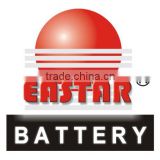mf n50z car battery
USD $1 - $50 /Set
Min.Order:50 Sets
Quick Details View All >
Shenzhen Eastar Battery Co., Ltd.
Product Details
Prodcut Name: mf n50z car battery
1)CE, ISO9001
2)good start-up capability
3)low self-discharge
4)Excellent Starting Performance
Specification:
| DIN Model | New Type (JASO) | Voltage (V) | Capacity (AH) | Dimensions(mm) | Weight (kg) | Cranking Ampere at -15 °C(Amp) | Cell Layout (Fig No) | Terminal Type |
| L*W*H/T.H | ||||||||
| N100 | - | 12 | 100 | 410*175*225mm | 16.4 | 500 | 0 | A |
Attention:
1) Do not handle battery roughly.
2) Do not drop water in the battery before electrolyte is filled.
3) See instructions before putting into service.
4) Sulphuric acid cause severe burn.
5) Keep away from spark.
6) Danger!Explosive
7) Wear goggle
Instruction for Putting Into Service
1) Fill cells with electrolyte(refined sulphuric acid) having a specific gravity as given in Table 1 to the proper level as given in Figure 1 When filling the electrolyte, temperature must not be lower than 15°C nor higher than 30°C. Note: if battery vent plugs are sealed with tapes, discard sealing tapes.
2) Allow battery to stand for some time after filling before placing on charge. If electrolyte level has drop, add more electrolyte until proper level is reached.
3) Place on charge at the proper rate as given in Table 13, charge until cell gases freely, and the voltage and specific gravity are constant over three times successive readings taken at 30 minutes intervals.
4) During the charge, do not allow electrolyte temperature to rise above the value as given in Table 1. Should this temperature be reached, reduce charging current. Electrolyte temperature is below -15°C, charge at a half of less of the proper current in the long time, or charge at normal charging current after keeping the battery in a warm room for about 24 hours.
5) Don’t fill a hole of vent plugs
6) Keep vent plugs tight
7) Consider that the battery should be kept warm and that charge states should be accurate in order to keep electrolyte free from freezing in the cold season.
8) Grounded terminals of the battery are desirable to be disconnected in a long standing period installing battery in vehicle.
9) The battery should not be attached to petroleum or contacted to vinyl chloride.
Table 1
SG of electrolyte required under full charged.(20°C) | Hot Climate 1.240 | Tropical Climate 1.260 | Cold Climate 1.280 |
SG of sulphuric acid for filling new Cells. (20°C) | 1.230-1.240 | 1.250-1.270 | 1.270-1.290 |
SG of electrolyte at end of charge (fully charged)(20°C) | 1.230-1.240 | 1.250-1.270 | 1.270-1.290 |
Maximum permissible temperature of electrolyte during charge | 50°C | 45°C | 45°C |
Table 1
SG of electrolyte at end of charge (fully charged). (20°C) | 1.240 | 1.260 | 1.280 |
Value of SG of electrolyte. (20°C) | Less than 1.190 | Less than 1.200 | Less than 1.220 |
General Notice
1)Battery should be secured firmly in the vehicle in a proper manner.
2)Charge battery fully as soon as it is over discharge.
3)An open flame or spark should not be brought too close to the battery.
4)If the temperature of electrolyte is extremely low, it is difficult to determine whether battery is fully charged and charging efficiency becomes poor. Therefore, when be sure marked POS cable is connected to POS (+) terminal. Connect NEG(-) cable last to prevent dangerous sparks. DO NOT OVER TIGHTEN! It’s a good idea to install special corrosion retarding fiber washers around terminals to help extend battery life.
5)Side terminal batteries need special care. Over tightening the terminal bolts will severely damage the battery and could cause a dangerous explosion. Use a special side terminal torque tool to avoid this hazard.
6)Coat the terminals and exposed metal parts around the battery with a good quality protective spray.
Table 3
Initial charge current AMP | 0.08XC |
Normal Charge current AMP | 0.1XC |
C: Battery Capacity (Amp) at 20 hour rate | |
Contact Supplier

You May Like
New Products
Popular Searches
Recommended Products
Find Similar Products By Category